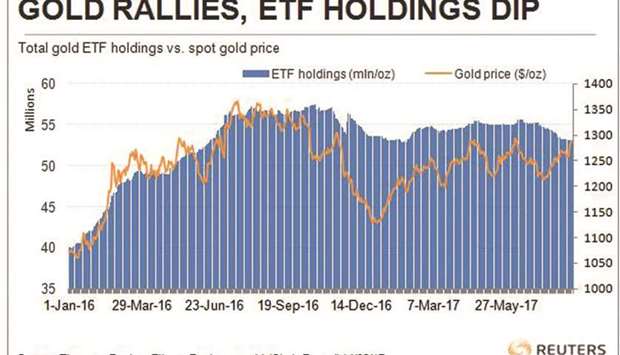Spot gold has jumped 7% from its recent intra-day low on July 10 to close at $1,288.81 an ounce on August 11, it’s highest in two months.
The precious metal is up 12% since the end of last year, and while there have been other factors behind the gains, the froth in the rally is almost certainly down to its appeal as a safe haven in times of heightened political risk.
Trump’s use of the social media site Twitter to threaten “fire and fury” against North Korea certainly raised the tensions around the isolated dictatorship’s pursuit of nuclear weapons capable of reaching the continental United States.
The US President later doubled down on his tweet, saying perhaps it didn’t go far enough, raising fears that Trump would go as far to consider a pre-emptive strike on North Korea, a move that could escalate into retaliatory attacks on neighbours and US allies South Korea and Japan.
The geopolitical tensions stoked by Trump are grist to the mill for gold, but it’s also likely the case that a sustainable rally for the yellow metal can’t be built on the threat of conflict alone.
At some point the conflict either becomes real, or the tensions start to ease as calmer heads make their presence felt on all sides of the dispute.
For gold to continue making headway, it’s generally the case that all, or at least most, of the drivers of the price are working in tandem.
Gold slumped after Trump’s election last November as investors took the view that the insurgent Republican leader would be good for economic growth and thus inflation in the United States, thereby prompting interest rate increases by the Federal Reserve. With this optimism fading, but not quite gone yet, the outlook for monetary tightening by the Fed is being scaled back, which removes a headwind for gold.
The state of physical demand, particularly in the top two consumers China and India, tends to take a backseat in coverage of the gold market, but it is a crucial component.
On the positive side, India’s demand appears to be regaining strength, with World Gold Council data showing the South Asian nation’s demand at 167.4 tonnes in the second quarter, up strongly compared to both the 131 tonnes in the previous quarter and the 122.1 tonnes in the same period last year.
It’s possible that India’s gold imports will continue to increase in the second half of this year, given demand created by a good monsoon season, which boosts rural incomes.
The picture is somewhat mixed for China, with overall second quarter demand at 200.3 tonnes, down from 281.5 tonnes in the first quarter, but up from the 185.8 tonnes in the same period in 2016.
Jewellery demand growth in China has been on a declining trend in recent years, while investment demand for bars and coins has also slowed in the first half of this year from the second half of 2016 as fears over yuan depreciation and government restrictions on other types of investment eased.
India’s consumer demand is up by 69.1 tonnes in the first half of 2017 compared to the same period last year, while China’s is 35.5 tonnes higher.
Together, this additional demand of 104.6 tonnes has helped support prices, but by itself probably isn’t enough to drive a sustained rally.
For that to happen, investor flows will have to make more of a contribution, something that becomes possible if investors continue to seek a safe haven, or see increasing chances of declines in global equity markets as the optimism surrounding Trump’s hoped-for economic stimulus and tax cuts fades.
Exchange-traded funds (ETFs) for gold recorded net inflows of just 56 tonnes in the second quarter, down from 111.9 tonnes in the first quarter, according to the Council statistics.
The net flows into ETFs in the first half of 2017 was 167.9 tonnes, down 71% from the 579.4 tonnes reported for the first half of 2016.

